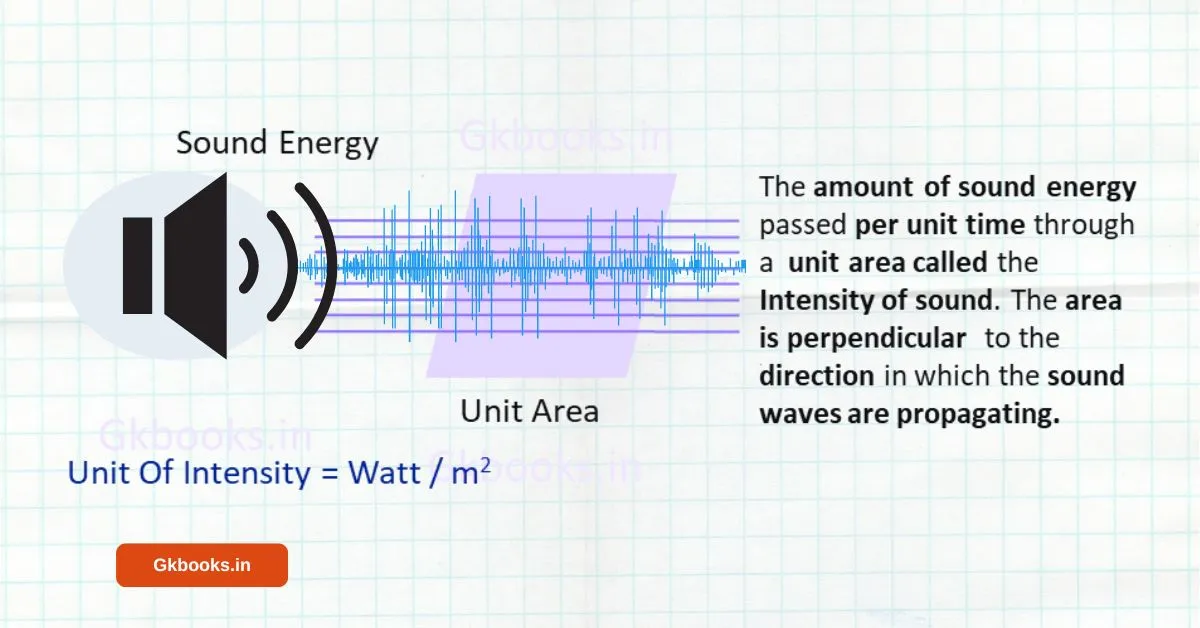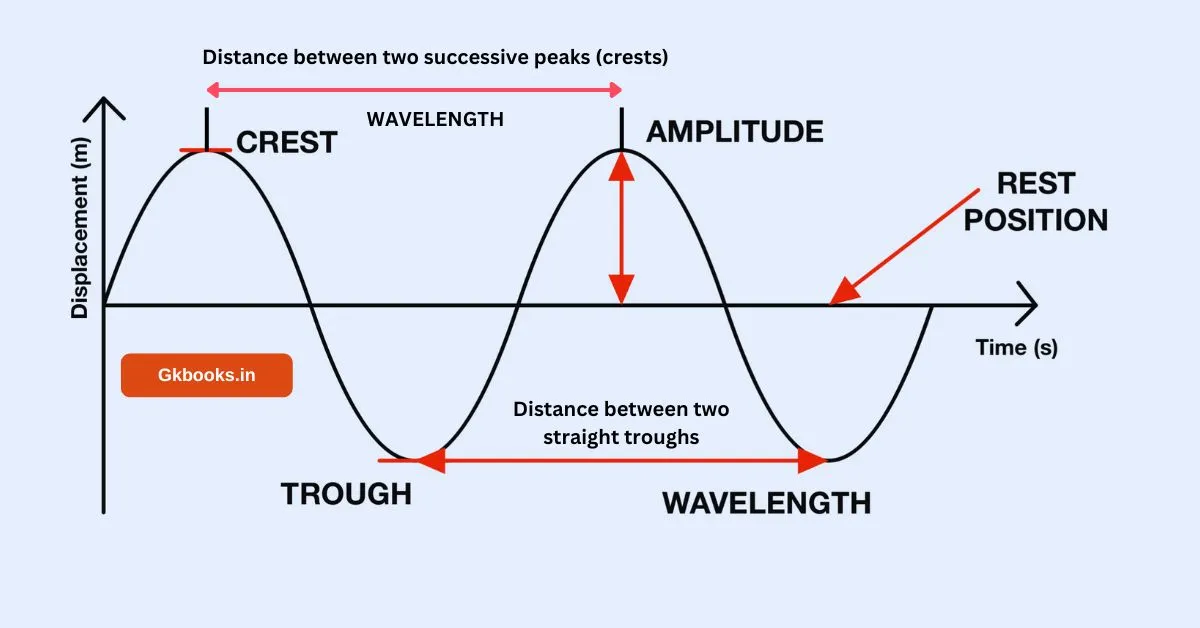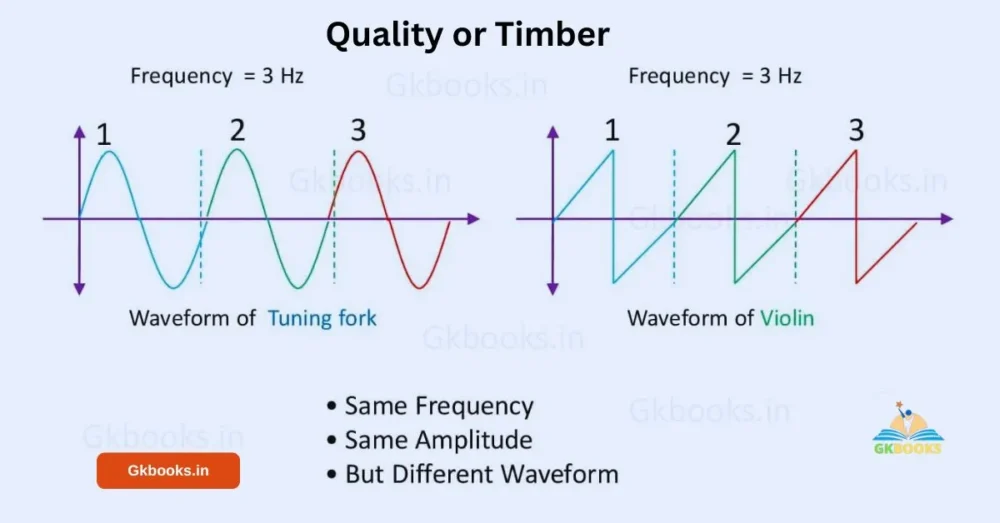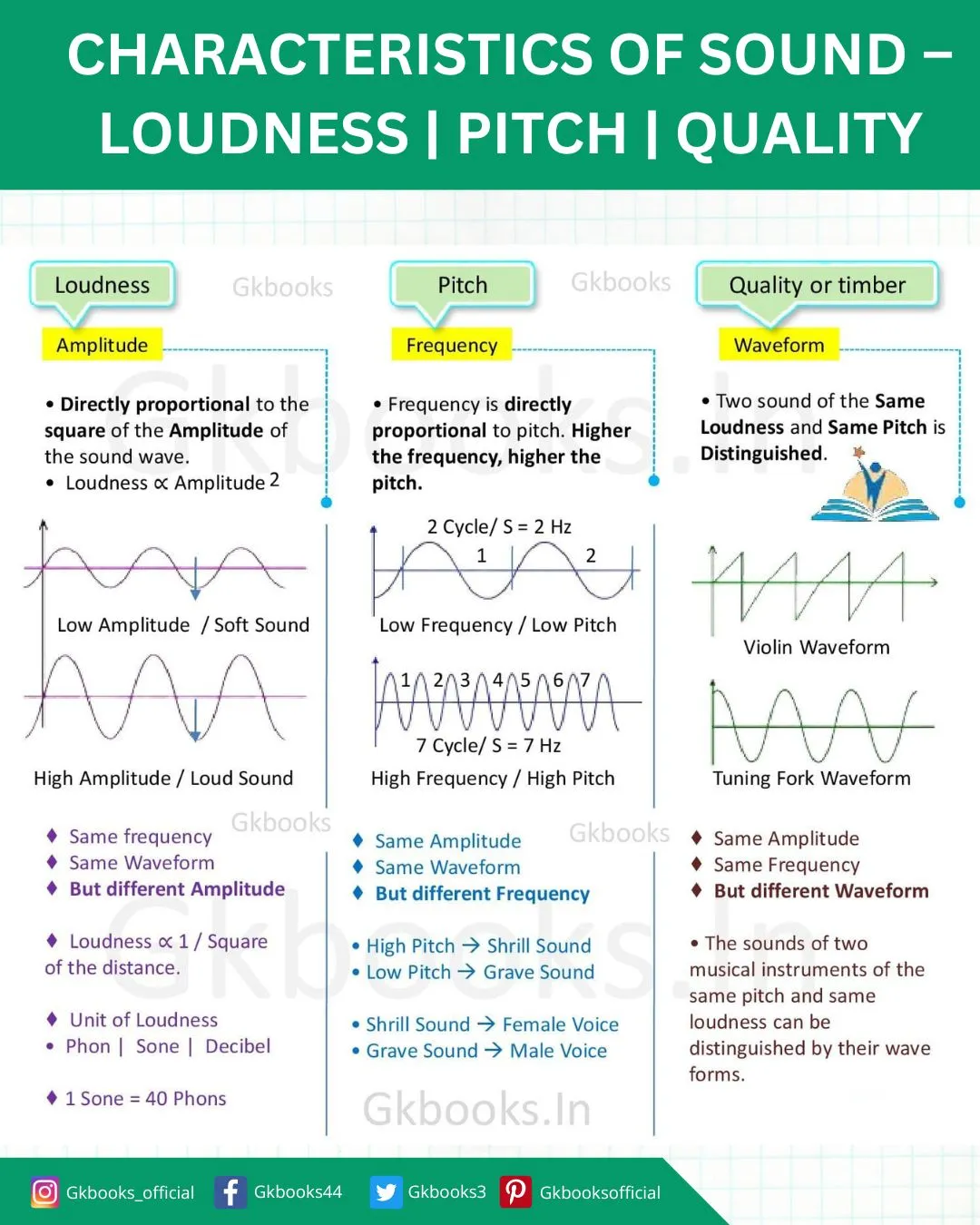Sound is all around us! Whether it’s music, a ringing phone, or a person talking, sound waves help us hear different noises. But what makes sounds loud or soft, high or low, clear or unclear? These features are called the characteristics of sound.
In this article, we will explore the different properties of sound, such as pitch, loudness, timbre, and speed, with easy explanations and examples. Understanding these concepts is important for competitive exams like SSC, Banking, RRB NTPC, UPSC, and state-level exams.
Let’s explore the world of sound and learn what makes each sound unique! 🚀
What is Sound?
Sound is a form of energy that travels through a medium (such as air, water, or solids) in the form of waves. It is created by vibrations, and when these vibrations reach our ears, our brain interprets them as sound.
How is Sound Produced?
For sound to exist, three essential elements are needed:
- A Vibrating Source – Something must vibrate to produce sound (e.g., a guitar string or vocal cords, tuning fork).
- A Medium to Travel Through – Sound needs air, water, or solids to propagate.
- A Receiver (Our Ears) – The vibrations must be detected by our ears and brain to be recognized as sound.
Nature of Sound Waves
- Sound travels as a longitudinal wave, meaning particles in the medium vibrate parallel to the direction of the wave.
- It requires an elastic medium to propagate, which is why sound cannot travel in a vacuum (like space).
Key Takeaways:
✅ Sound is energy that travels in waves.
✅ Vibrations create sound, and our ears detect them.
✅ Sound needs a medium (air, water, or solids) to travel.
✅ Sound cannot travel through a vacuum because it requires a medium.

Importance of Understanding Sound Characteristics
Understanding the characteristics of sound is crucial in music, engineering, physics, and daily life. It helps us appreciate different sounds, improve communication, and apply knowledge in various fields.
1. Enhanced Appreciation of Sound
🎵 Richer Music Experience
- Understanding frequency and pitch helps us differentiate between a flute’s high-pitched notes and a cello’s deep bass.
- Knowledge of amplitude and loudness allows us to enjoy the dynamics in music, from soft melodies to powerful beats.
🎤 Distinguishing Different Sounds
- Timbre (Sound Quality) helps us identify voices and instruments.
- A piano and violin playing the same note sound different because of their unique timbre.
2. Applications in Various Fields
🏛️ Acoustics & Sound Engineering
- Architects and sound engineers design concert halls, cinemas, and recording studios for the best sound quality.
- Noise-canceling headphones use sound wave properties to block unwanted noise.
🔬 Physics & Science Applications
- Seismology: Understanding sound waves helps scientists study earthquakes.
- Medical Imaging: Ultrasound technology uses sound waves for health diagnostics.
3. Everyday Benefits
🌍 Understanding Our Environment
- Car honks warn us of danger.
- Birds chirping signal a peaceful setting.
🗣️ Improved Communication
- Controlling volume and clarity improves speech and prevents misunderstandings.
- Public speakers, teachers, and broadcasters rely on sound properties for effective communication.

✅ Total Internal Reflection, Definition, Conditions, Application
Core Characteristics of Sound Waves
Frequency and Pitch Explained
Sound waves are invisible energy disturbances that travel through a medium (air, water, or solids), allowing us to hear and perceive sound. These waves have key characteristics that shape our auditory experience. One of the most important properties is frequency, which determines the pitch of a sound.
What is Frequency in Sound Waves?
🔍 Defining Frequency
- Frequency refers to the number of vibrations (oscillations) per second in a sound wave.
- It is measured in Hertz (Hz), where 1 Hz = 1 cycle per second.
- More vibrations per second = higher frequency (high-pitched sound).
- Fewer vibrations per second = lower frequency (low-pitched sound).
How Frequency Affects Pitch
🎵 High Frequency = High Pitch
- Sounds with many vibrations per second are perceived as high-pitched (e.g., a whistle, violin, or bird chirping).
🎶 Low Frequency = Low Pitch
- Sounds with fewer vibrations per second are heard as low-pitched (e.g., a drumbeat, thunder, or deep male voice).
Real-Life Analogy: Jump Rope Example
Think of a jump rope:
- Swing it fast → Small, quick jumps = high-pitched sound (high frequency).
- Swing it slow → Large, slow jumps = low-pitched sound (low frequency).
By understanding frequency, we can predict how high or low a sound will be in everyday life, music, and technology.
✅ Different types of work done, Definition, Units, and Dimension
Amplitude: The Loudness of the Sound
Amplitude is a key characteristic of sound waves, referring to the height or maximum displacement of the wave from its resting position. It plays a crucial role in determining the loudness of sound. Let’s break it down.
What is Amplitude in Sound Waves?
- Amplitude measures the intensity or strength of sound waves.
- A larger amplitude means a louder sound, while a smaller amplitude results in a softer sound.
How Amplitude Affects Loudness
🔊 Larger Amplitude = Louder Sound
- When sound waves have larger amplitudes, the pressure variations in the medium (like air or water) are more pronounced.
- This results in a louder sound that our ears perceive as being stronger and more intense.
🎶 Smaller Amplitude = Softer Sound
- When sound waves have smaller amplitudes, the pressure variations are less significant.
- This leads to a softer sound, with less intensity and a gentler perception.
Real-Life Analogy: Volume Control
Think of amplitude like the volume knob on your music system:
- Turning the knob up increases the amplitude, making the sound louder.
- Turning the knob down reduces the amplitude, making the sound softer.
Units for Measuring Loudness
While amplitude itself isn’t directly measured in meters or centimeters, loudness (a perception of sound intensity) is quantified using the following units:
📏 Phon (ph)
- 1 phon equals the loudness of a 1000 Hz (1 kHz) pure tone at the threshold of hearing.
📈 Sone
- A sone is defined as the loudness equal to 40 phons. A sound perceived as twice as loud is rated as 2 sones.
🔊 Decibel (dB)
- The decibel (dB) is a widely used unit for sound pressure level.
- A 10 dB increase is often perceived as doubling the loudness.
✅ Points to Remember
🔹Phons and sones are more directly tied to human perception of loudness, while decibels measure sound pressure level.
🔹Decibels are often used with a reference level to specify loudness. For example, 0 dB refers to the hearing threshold and sounds above 120 dB can be considered uncomfortable or painful.
🔹Intensity: As you mentioned, sound intensity is the objective measure of sound energy per unit area. While not directly representing loudness, it is a physical property that can be used to calculate loudness based on models that account for human hearing.
✅ Loudness Exam-oriented Key Points
🔸 Loudness is an auditory sensation in which our ear can precept a sound. 🔸It is a subjective Quantity.
🔸 The Loudness or softness of a sound depends on the Amplitude of that sound wave.
🔸The Loudness is directly proportional to the square of the Amplitude of the sound wave.
🔸The Loudness of a sound wave is Inversely proportional to the square of the distance between the sources.
🔸 Loudness also depends on the density of the medium; more density means more Loudness.
🔸 Also, it depends on the Surface area of the vibrating body; more surface area produces more Loudness.
🔸Amplitude refers to the maximum displacement or distance moved by a point on a vibrating body or wave from its equilibrium position, representing the magnitude of the wave’s disturbance in the medium.
🔸 It is usually represented by the letter ‘A’.
🔸Compared to soft sound, a Louder sound can travel a distance because a louder sound has higher energy.
Sound Intensity
Sound intensity refers to the amount of sound energy passing through a unit area in a given time. It plays a key role in determining how loud or soft a sound appears to us.
What is Sound Intensity?
- Sound intensity measures the energy that is transferred through a medium, such as air, water, or solids, per unit area.
- This area is always perpendicular to the direction of sound wave propagation.
SI Unit of Sound Intensity
- The SI unit of sound intensity is watt per square meter (W/m²).
Objective Nature of Sound Intensity
- Unlike loudness (a subjective perception), sound intensity is an objective quantity, meaning it can be measured with specific numerical values.
- For example, a sound intensity of 5 W/m² remains the same for everyone, making it a standardized measure.
Weakest Sound Intensity
- The zero-decibel sound represents the weakest sound intensity, equivalent to 10⁻¹² watts per square meter (W/m²).
- This is the threshold below which sound is no longer audible to the average human ear.
Why Is Sound Intensity Important?
It also plays a critical role in areas like environmental noise control and medical diagnostics (e.g., ultrasound technology).
Sound intensity helps quantify sound energy, making it essential for applications such as audio engineering, acoustics, and noise measurement.

Wavelength
Wavelength is one of the key characteristics of sound waves that directly influences how we perceive the pitch of sound. In simple terms, it’s the distance between two consecutive identical points on a wave, like the distance between two peaks or troughs of a sound wave.
What is Wavelength in Sound Waves?
- Wavelength refers to the physical distance between two successive crests (peaks) or troughs of a sound wave.
- It plays a crucial role in determining the pitch of sound.
How Wavelength Affects Pitch
Longer Wavelengths:
- A sound wave with a longer wavelength has greater distances between the peaks or troughs.
- This results in slower vibrations of the medium, which our ears interpret as lower-pitched sounds, often described as deep or bass.
Shorter Wavelengths:
- A sound wave with a shorter wavelength has shorter distances between the peaks or troughs.
- This results in faster vibrations of the medium, which we perceive as higher-pitched sounds, often described as shriller or thin.
The Inverse Relationship Between Wavelength and Frequency
- Wavelength and frequency have an inverse relationship. This means that as the wavelength increases, the frequency decreases, and vice versa.
- The formula for this relationship is:
v = fλ
Where:
v = speed of sound in the medium (constant for a given medium)
f = frequency of the sound wave (measured in Hertz)
λ = wavelength (measured in meters)
- As the speed of sound in a given medium remains constant, a shorter wavelength (faster vibrations) corresponds to a higher frequency to maintain this constant speed.
Analogy: Understanding Wavelength with a Piano
Think of the wavelength as the distance between piano keys:
- Pressing a lower-pitched key on the left (with a longer key) produces a lower pitch, just like a longer wavelength.
- Pressing a higher-pitched key on the right (with a shorter key) produces a higher pitch, just like a shorter wavelength.

Additional Characteristics of Sound
Beyond the fundamental properties of frequency, amplitude, and wavelength, sound waves have additional characteristics that shape our perception. One of the most important is Timbre (Sound Quality).
What is Timbre?
- Timbre (also called sound quality) is what makes different sounds unique, even if they have the same pitch and loudness.
- It is the reason a flute sounds different from a violin playing the same note or why human voices are distinguishable from each other.
What Creates Timbre?
Timbre is determined by the harmonic content of a sound wave. Unlike pitch (which depends on frequency) and loudness (which depends on amplitude), timbre is influenced by:
- Harmonics (Overtones) – Additional higher frequencies present in a sound.
- Waveform Complexity – The shape and structure of the sound wave.
- Resonance and Material Properties – How a sound-producing object vibrates.
Most sounds are not pure tones but complex waveforms consisting of a fundamental frequency (the main note) and harmonics (higher frequencies). The specific combination of these harmonics gives each sound its unique timbre.
Analogy: Sound Waves vs. Light Waves
- Think of sound waves like light waves.
- Pure white light contains all colors combined, but when passed through a prism, it splits into individual colors.
- Similarly, a musical instrument produces a complex sound wave, made up of many frequencies. The way these “sound colors” mix determines the timbre of the sound.
Why is Timbre Important?
Timbre is crucial in various aspects of sound perception:
✅ Music – Helps differentiate musical instruments.
✅ Speech Recognition – Allows us to recognize different voices.
✅ Audio Technology – Used in sound engineering and music production.
✅ Timber or Quality of Sound Key Points
🔹 It is a characteristic of the Sound wave by which we can differentiate two sounds having the Same Pitch and Loudness.
🔹 The Quality of timber depends on the Waveform of the sound wave.
🔹 The more pleasant sound is said to be of rich quality.
🔹 A Single frequency (single cycle) sound is called a Tone.
🔹 A sound produced due to a combination of several tones is called a Note.
🔹 Noise is unpleasant to the ear while music is pleasant to the ear.
🔹 Music and Noise are both closely related to the waveform produced by any musical instrument.
Music and Noise, are both subjective quantities.
☛ The musical sound waveform is Regular, Smooth, Continuous, and Periodic.
☛ Whereas the noise waveform is irregular, harsh, discontinuous, and non-periodic.

Speed of Sound
What is the Speed of Sound?
The speed of sound refers to how fast sound waves travel through different mediums like air, water, and solids. It is measured in meters per second (m/s) or kilometers per hour (km/h).
Factors Affecting the Speed of Sound
Unlike sound wave properties such as frequency, amplitude, and wavelength, the speed of sound primarily depends on the medium through which it travels. Here are the key factors:
1. Density of the Medium
- Sound travels faster in denser materials because particles are closer together, allowing vibrations to transfer more efficiently.
- Example: Sound moves faster in steel (a dense solid) than in air (a less dense gas).
2. Temperature
- Higher temperatures increase the speed of sound because warmer particles vibrate with more energy, facilitating faster wave transmission.
- Example: Sound travels faster in hot air than in cold air.
3. Composition of the Medium
- Different materials have unique elastic properties, affecting sound speed.
- Example: The speed of sound in metals varies depending on their composition.
Speed of Sound in Different Media
| Medium | Speed of Sound (m/s) | Speed of Sound (ft/s) |
|---|---|---|
| Air (20°C) | 343 m/s | 1,125 ft/s |
| Water | 1,484 m/s | 4,867 ft/s |
| Steel | 5,100 m/s | 16,733 ft/s |
Key Observations:
- Sound travels nearly 4 times faster in water than in air.
- Sound is over 15 times faster in steel than in air.
Importance of the Speed of Sound
The concept of sound speed plays a crucial role in various fields:
1. Locating Sound Sources
- Used to estimate lightning strike distances by measuring the time gap between the flash and thunder.
2. Medical Imaging
- Ultrasound technology relies on sound speed to create images of internal organs for medical diagnosis.
3. Aerodynamics and Sonic Booms
- In aeronautics, understanding the speed of sound is essential for supersonic flight and sonic boom analysis.
Difference between Intensity and Loudness
| Characteristic | Intensity | Loudness |
|---|---|---|
| Definition | The amount of energy transmitted per unit area by a sound wave, typically measured in watts per square meter (W/m²). | The subjective perception of the strength or volume of a sound, influenced by the amplitude of the sound wave. |
| Objective/Subjective | Objective – It can be measured directly with instruments and quantified with numerical values. | Subjective – It varies from person to person and depends on individual auditory perception. |
| Measurement | Typically measured in watts per square meter (W/m²) or decibels (dB), using sound level meters or similar devices. | Not directly measurable but can be inferred from intensity measurements and psychoacoustic principles. |
| Influence | Determined by the amount of energy carried by the sound wave, affected by factors such as distance from the source and medium properties. | Influenced by the amplitude and frequency of the sound wave, as well as psychoacoustic factors such as masking and auditory adaptation. |
| Standardization | Can be standardized and measured consistently using calibrated instruments. | Difficult to standardize due to its subjective nature, although standardized psychoacoustic models exist for approximating loudness. |
| Applications | Important in fields such as physics, engineering, and environmental noise assessment. | Relevant in fields such as psychology, audio engineering, and product design, particularly in areas where human perception of sound quality is crucial. |
Objective vs Subjective Quantity
| Characteristic | Objective Quantity | Subjective Quantity |
|---|---|---|
| Definition | Quantities that have a definite value and are identical for every person. | Quantities that vary from person to person based on individual perception. |
| Example | Decibel (dB), intensity of sound (e.g., 100 dB, 5 watt/m²) | Loudness (e.g., 100 dB) |
| Measurement | Measured directly with instruments, expressed with numerical values and units. | Depends on individual perception and cannot be measured directly. |
| Consistency | Consistent across different observers or measurements. | Varies among individuals, influenced by factors such as physiology and psychology. |
| Application | Widely used in scientific, engineering, and quantitative contexts where standardization is necessary. | Important in fields such as psychology, music, and design, where individual experience and perception are key. |
| Examples of Use | Physics, engineering, environmental noise assessment. | Audio engineering, psychology, aesthetics. |
Difference between – Amplitude, Pitch, and Waveform
Here’s a comparison between amplitude, pitch, and waveform presented in a tabular format:
| Characteristic | Amplitude | Pitch | Waveform |
|---|---|---|---|
| Definition | The magnitude or strength of a sound wave, which determines its loudness. | The perceived frequency of a sound wave, determining its highness or lowness. | The visual representation of a sound wave’s variation in air pressure over time. |
| Measurement | Typically measured in decibels (dB). | Measured in Hertz (Hz). | N/A (Represents the shape of the wave graphically). |
| Perception | Determines how loud or soft a sound is perceived. | Determines how high or low a sound is perceived. | Represents the pattern of oscillations in the air pressure over time. |
| Influence | Higher amplitudes result in louder sounds. | Higher pitch corresponds to higher frequency sounds. | Different waveforms represent various types of sounds (e.g., sine, square, sawtooth). |
| Application | Used to control the volume or loudness of audio signals. | Important in music theory and speech perception. | Used in audio editing and synthesis to manipulate sound characteristics. |

Top One Liner about the Characteristics of sound
Here’s the corrected version of your one-liner Q&A:
Q1: What is the SI unit of Frequency?
Answer: Hertz (Hz)
Q2: What is the SI unit of Sound Intensity?
Answer: Watt per square meter (W/m²)
Q3: What term describes the amount of energy passing through a unit area?
Answer: Intensity
Q4: Is Loudness an objective or subjective quantity?
Answer: Subjective Quantity
Q5: How does sound help distinguish two different musical instruments?
Answer: Quality or Timbre
Q6: What is the characteristic waveform of Noise?
Answer: Irregular, harsh, and discontinuous
Q7: What factor determines the Quality or Timbre of a sound?
Answer: Waveform
Q8: How is a high-quality sound described?
Answer: More pleasant
Q9: What term describes the number of waveforms produced per unit of time?
Answer: Frequency
Q10: What does a high-pitched sound correspond to?
Answer: High frequency
Q11: How can the voices of males and females be distinguished?
Answer: Pitch
Q12: What is the unit of measurement for loudness?
Answer: Decibel (dB)
Q13: What is the intensity of the softest sound that can be heard?
Answer: 0 dB
Q14: What is the intensity of the softest sound in terms of watts per square meter?
Answer: 10−1210^{-12} watt per square meter (W/m²)
Q15: Which characteristic of sound depends on amplitude?
Answer: Loudness
FAQs
The three main characteristics of sound are Pitch, Loudness, and Quality (Timbre).
Loudness is related to Amplitude.
Answer: Two different musical instruments
Answer: Pitch
Answer: Loudness


